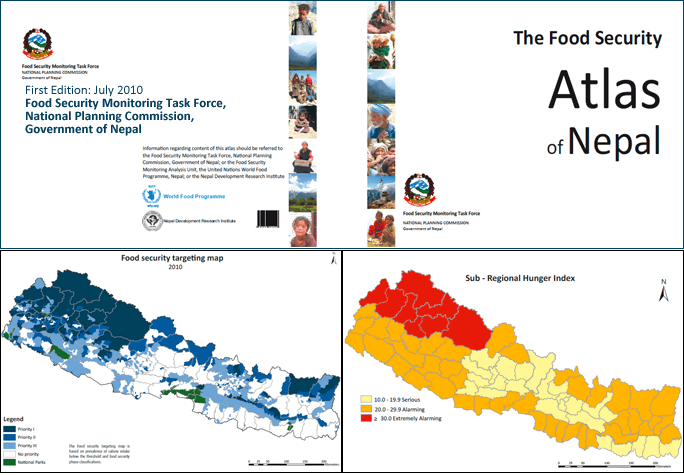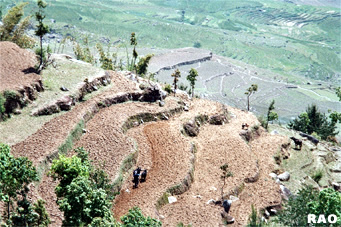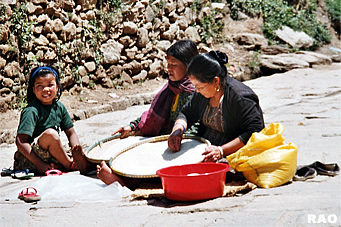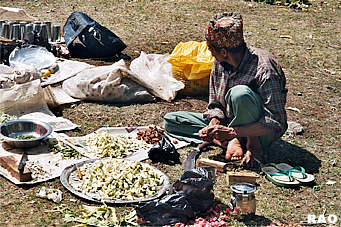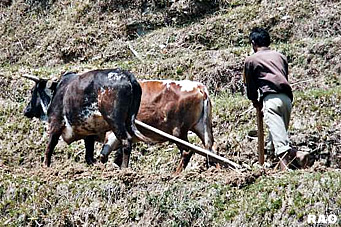| Development
in Nepal: Reports on Food Crisis |
 |
Nepal Development |
|
 |
Nepal Development |
|
|
 |
|
Food Security Atlas
|
 |
KATHMANDU,
21 Jul 2010 (WFP)
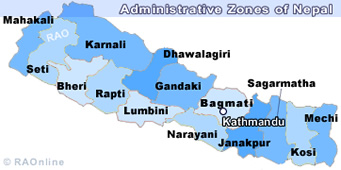 |
|
This first edition of the Food Security Atlas of Nepal was produced jointly by the United Nations World Food Programme (WFP) and the Nepal Development Research Institute (NDRI) under the overall guidance and supervision of the Food Security Monitoring Task Force of the National Planning Commission (NPC). |
|
The aim of the Food Security Atlas is to contribute to a better understanding of the spatial patterns of food security, poverty and malnutrition in Nepal in order to provide a solid basis for developing a comprehensive national food security plan. This is achieved through the mapping of a series of food security indicators and a spatial analysis of these data and indicators.
top
|
Far and Mid-West Hill and Mountain region - Food Security
|

|
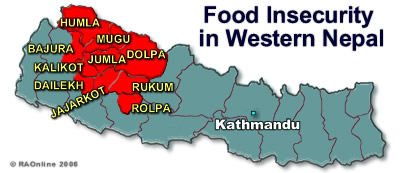 |
| As expected, between January and March the food security
situation deteriorated in parts of the Mid- and Far-Western
Hill and Mountain districts. This is primarily attributed to the
poor summer crop production in November/December 2009.
In highly and severely food insecure areas, households have
depleted their food stocks and basic food prices have
increased by 20 percent or more compared to the same time
last year. |
|
Under- and unemployment is a huge problem in
these areas with very little opportunities for income
generating activities.
• Bajura continues to be the district of major concern. 105,100 people (equivalent to 85 percent of the total district population) are classified as highly or severely food insecure with four VDCs in a critical stage of food insecurity. Other districts of concern are: Humla, Mugu, Kalikot, Jumla, Dailekh, Achham, Doti, Bajhang, Darchula, and Baitadi. The food security situation in these districts will remain critical until the next harvest is ready.
• The winter crop will be harvested in April and May. The outlook for the winter crop production is good across the country. This is expected to improve the food security situation over the next quarter. The majority of households in highly or severely food insecure VDCs expect their winter crop outlook will be normal or moderately impaired.
• Localized natural disasters including hailstorm, heavy snowfall and drought damaged the winter crop in parts of Rukum, Dailekh, Bajura, Dang, Siraha and Saptari. These areas are anticipated to face winter crop losses of between 30-60 percent.
• Sale of NTFP (Non-Timber Forest Products) including yarchagumba will be at its peak during the next quarter (Yarchagumba is collected during the month of May). Employment opportunities are expected to improve with increased development activities as the government’s FY endapproaches. In-migration during this period and hand-carried remittances from India will improve households’ access to food. Improved access along the Karnali highway as well as the opening of the Chinese border (expected in May) are other factors contributing to the positive outlook.
• The market prices of staple food commodities are anticipated to increase until the winter harvest becomes available. Political instability and bandhs will cause market disruption over the coming months as the 28th of May deadline for the pre-announced date of constitution promulgation approaches.
• Traditionally April to June is the period when cases ofwater-born diseases including dysentery, cholera, typhoid, giardia etc. are more prominent. Vulnerable, food insecure populations are more likely to be affected by such diseases. Last year, nineteen districts in the Mid– and the Far-western Hill and Mountain regions were affected, resulting in more than 300 diarrhea related death cases during the period of May to August 2009. The government of Nepal is working closely with development partners to improve water quality, educate communities on proper hygiene and sanitation and have medicinal stocks in place.
| Source: United Nations World Food Programme (WFP), excerpt from Nepal Food Security Bulletin - Issue 27, January - March 2010 |
 |
top
|
Links
|
 |
 |
 |
External
link |
|
more information
|
 |
|



